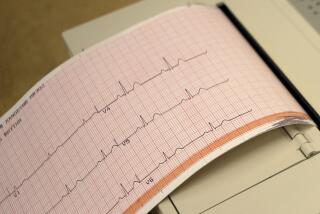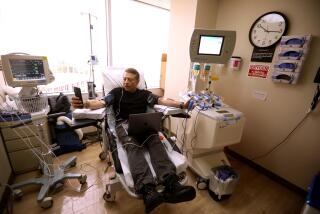High-Tech Gain in Modern Medicine Wields Hefty Price Tag : Health care: Magnetic imaging is among new diagnostic tools aiding surgeons, all at a cost to the nation’s economy.
- Share via
WASHINGTON — A few months ago, Anne Thurston said, she began to get “intense pains in my right knee while walking up and down stairs and jogging in Rock Creek Park” here.
When the X-ray her doctor ordered “did not show anything that could be the cause of the problem,” she said, her doctor sent her for a scan by the new diagnostic wonder: a magnetic resonance imaging machine.
Because an MRI can see soft tissue, it found what the long-used diagnostic tool, the X-ray, could not: torn cartilage and two bones scraping together, said Thurston, a fellow at the Woodrow Wilson International Center for Scholars here.
The X-ray cost only $75, but it proved useless; the MRI cost about $1,100 but found the problem. Thurston underwent arthroscopic surgery, another relatively recent medical advance. That cost $2,300 in surgeon’s fees alone, but within 10 days she was walking normally and within two months was jogging.
As Thurston’s case illustrates, technological advances can produce better health results, but at a high cost. Changes in technology are a major cause of rising health care costs--accounting for as much as 25% to 50% of the annual increase after inflation is taken into account, according to specialists.
That presents planners with an unpalatable scenario: It may be impossible to curb health costs without also limiting or rationing new technologies that can enhance human health and well-being, according to William B. Schwartz, a physician and health-policy analyst at Tufts University medical school.
“The genius of the biomedical community has created a cornucopia of benefits that cannot be fully exploited if we mean business about slowing the cost spiral,” Schwartz said.
“The impact of technology is particularly great in the health field because good health is such a preeminent personal value that people are willing to spend much more on it than on other goods and services. This, in turn, encourages technology groups and firms to do the necessary research and development in order to bring new products to market,” said Donald A. Young, executive director of the Prospective Payment Assessment Commission, which advises Congress on hospital issues.
“We are receiving better care, but the cost is killing us,” said Rep. Pete Stark (D-Oakland), chairman of the House Ways and Means health subcommittee.
The United States has eight times more MRI and radiation therapy units per capita and three times more cardiac catheterization and open-heart surgery units per capita than Canada.
Numerous new--and expensive--technologies, drugs and procedures are available. Just three of them could add $5 billion to the nation’s yearly health tab, Schwartz said. They are:
* The automatic implantable cardioverter defibrillator, an electronic device that is implanted in the skin and has a built-in computer to slow a heart when it is beating dangerously fast in patients with arrhythmia.
* Erythropoietin, a hormone that stimulates production of red blood cells in kidney patients and some other types of patients whose levels have fallen dangerously.
* Low osmolar contrast media, an opaque dye that is used in X-rays and better highlights the brain, kidney and heart in certain cases.
With dozens of other costly technologies coming on line, is there any hope for holding down medical spending without rationing? Schwartz does not think so; other health care experts offer two major theories on how cost savings might be achieved.
One theory holds that there is so much waste in the medical system that eliminating it not only could save enough to pay for future technological marvels but also could provide insurance for the tens of millions of people who lack adequate coverage.
The other theory holds that technological advances will be cheaper than the treatments they replace, reducing costs in the long run.
“About a third of what we do we could get rid of without missing it. . . . It has less benefit than a lot of cosmetic surgery,” said Robert H. Brook, vice chairman of medicine at the UCLA and director of Rand Health Services.
Brook based his assertion on studies in the early 1980s that found that 14% of coronary-artery bypass surgeries were medically inappropriate, as were 17% of coronary angiograms (dye-aided pictures of the coronary arteries) and 32% of carotid endarterectomies (widening a major artery that delivers blood to the brain).
“A quarter to a third of health-care costs is waste,” said Philip R. Lee, chairman of the Physician Payment Review Commission, which advises Congress on doctor-payment issues.
Although Brook gave no dollar estimate on potential savings, other analysts have estimated that wasteful spending on over-utilization of treatments and diagnostic devices could be as much as $100 billion to $200 billion a year of the $600 billion spent a year on personal health care.






